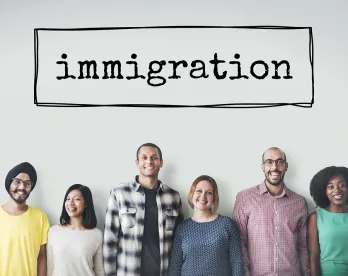On January 27, 2017, President Trump issued Executive Order 13769, entitled “Protecting the Nation from Foreign Terrorist Entry Into the United States,” (EO1), which went into effect immediately. In EO1, the president invoked his claimed authority to suspend the immigrant and nonimmigrant entry of nationals from Iran, Iraq, Libya, Somalia, Sudan, Syria, and Yemen into the United States for a period of at least 90 days. The order also immediately suspended the U.S. Refugee Admissions Program (USRAP) for 120 days, imposed an indefinite ban on entry of Syrian refugees, and limited the entry of refugees to 50,000 in fiscal year 2017.
The suddenness of the announcement of EO1 resulted in chaos across the various ports of entry to the United States, as different federal agencies attempted to execute an unprecedented order without any implementing guidelines or understanding of its scope. Two States, Washington and Minnesota, quickly filed a suit in a district court in Washington to enjoin EO1, and the district court issued a temporary restraining order (TRO), which halted the implementation of the ban. The federal government filed an emergency motion seeking to resume the ban pending appeal, which the district court denied on February 9, 2017. Instead of continuing with litigation, the federal government drafted a new executive order voluntarily dismissing its appeal.
On March 6, 2017, President Trump signed Executive Order 13209, which was also entitled “Protecting the Nation from Foreign Terrorist Entry Into the United States” (EO2), which went into effect on March 16, 2017. EO2 reinstated the 90-day ban on travel for nationals of six of the seven majority-Muslim countries from EO1, but did not include Iraq because of that country’s “close cooperative relationship” with the United States. EO2 was more narrowly tailored in scope and applied only to individuals outside of the United States who did not already possess a valid visa at the time of the issuance of both travel bans. EO2 explained that the six countries were selected because “Each of these countries is a state sponsor of terrorism, has been significantly compromised by terrorist organizations, or contains active conflict zones . . . the risk of erroneously permitting entry of a national of one of these countries who intends to commit terrorist acts or otherwise harm the national security of the United States is unacceptably high.” EO2 again suspended refugee admissions for 120 days and reduced the number of refugees to be admitted from 110,000 to 50,000 for fiscal year 2017.
The State of Hawaii also petitioned for a TRO challenging EO1, which it later amended to challenge EO2. The U.S. District Court for the District of Hawaii granted the TRO, and on March 29, 2017, it granted the State of Hawaii’s motion to convert the TRO to a nationwide permanent injunction prohibiting enforcement of EO2’s travel ban and refugee ban. The federal government appealed the injunction to the Ninth Circuit Court of Appeals, asking the court to vacate or narrow the injunction and to stay the injunction pending appeal.
On June 12, 2017, the Ninth Circuit issued a decision affirming the permanent injunction of Section 2(c) of EO2. In its decision, the Ninth Circuit discussed whether President Trump complied with conditions set forth in 8 U.S. Code §1182(f), which states:
Whenever the President finds that the entry of any aliens or of any class of aliens into the United States would be detrimental to the interests of the United States, he may by proclamation, and for such period as he shall deem necessary, suspend the entry of all aliens or any class of aliens as immigrants or nonimmigrants, or impose on the entry of aliens any restrictions he may deem to be appropriate.
The Ninth Circuit found that this section requires that “the President’s findings support the conclusion that entry of all nationals from the six designated countries, all refugees, and refugees in excess of 50,000 would be harmful to the national interest.” The Ninth Circuit found that EO2 does not offer a sufficient justification to suspend the entry of more than 180 million people on the basis of nationality because it “does not tie these nationals in any way to terrorist organizations within the six designated countries . . . In short, the Order does not provide a rationale explaining why permitting entry of nationals from the six designated countries under current protocols would be detrimental to the interests of the United States.”
Regarding Section 6(a), the Ninth Circuit found that EO2 “does not reveal any threat or harm to warrant suspension of USRAP for 120 days and does not support the conclusion that the entry of refugees in the interim time period would be harmful. Nor does it provide any indication that present vetting and screening procedures are inadequate.” In a footnote, the court refers to findings from an amicus curiae brief submitted by former national security officials that “[r]efugees receive the most thorough vetting of all travelers to the United States in a process that takes eighteen to twenty-four months.”
As to Section 6 (b), which restricts the entry of refugees to no more than 50,000 in fiscal year 2017, the court cites 8 U.S.C. §1157(a)(2):
[T]he number of refugees who may be admitted under this section in any fiscal year . . . shall be such number as the President determines, before the beginning of the fiscal year and after appropriate consultation, is justified by humanitarian concerns or is otherwise in the national interest.
The Ninth Circuit explains that this statute prescribed “specific actions the President must take before setting the number of refugees”—actions President Trump did not follow. As such, the court found that the State of Hawaii was likely to succeed on the merits of its argument that Section 6(b) conflicts with 8 U.S.C. §1157 and affirmed the permanent injunction of that section.
Finally, the Ninth Circuit found that the district court abused its discretion in enjoining those portions of Sections 2 and 6 that direct various government agencies to review worldwide vetting procedures. Since the states had not shown how the federal government’s internal review of its vetting procedures would harm them, the court vacated this part of the injunction. Further, the Ninth Circuit agreed with the federal government’s argument that the district court erred in issuing an injunction against the president himself. The court vacated the injunction to the extent that it enjoins the president personally, but affirmed the injunction against the government agencies charged with carrying out the travel and refugee bans. The Ninth Circuit remanded the case to the district court in Hawaii with instructions to reissue a preliminary injunction consistent with the opinion.
This decision is the second decision by a U.S. Court of Appeals to block EO2. The U.S. Court of Appeals for the Fourth Circuit in Richmond, Virginia decided the first case on May 26, 2017. The Fourth Circuit held that the executive order violated the First Amendment’s prohibition of government establishment of religion. The Trump administration has sought a writ of certiorari of that decision from the Supreme Court of the United States, which is currently pending. The government has not sought review of the Ninth Circuit travel ban decision, but it may still decide to do so. If the Supreme Court declines to review the Fourth Circuit’s EO2 case (or the Ninth Circuit’s EO2 case, if the government seeks review), or upholds either decision, the Trump administration would have three options: it could rewrite the executive order for a third time, it could continue the legal fight in the lower courts, or it could abandon the travel ban. We expect to know whether the Supreme Court has accepted or declined the Fourth Circuit’s travel ban case by the end of the term, which will be in late June or early July.





 />i
/>i
